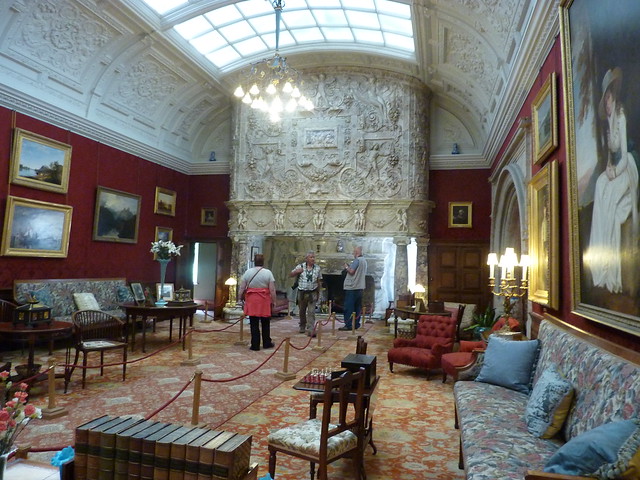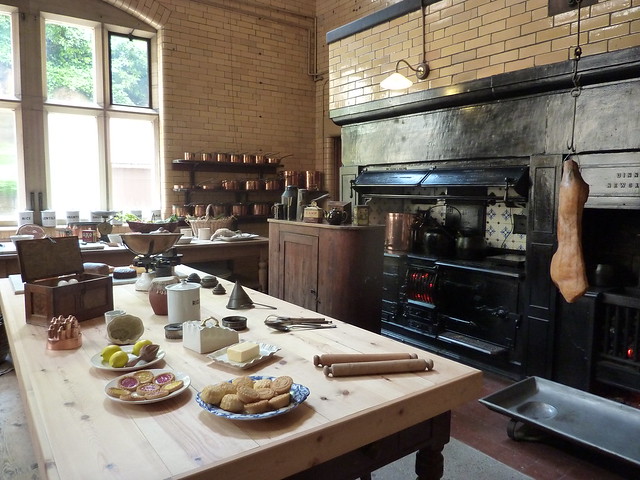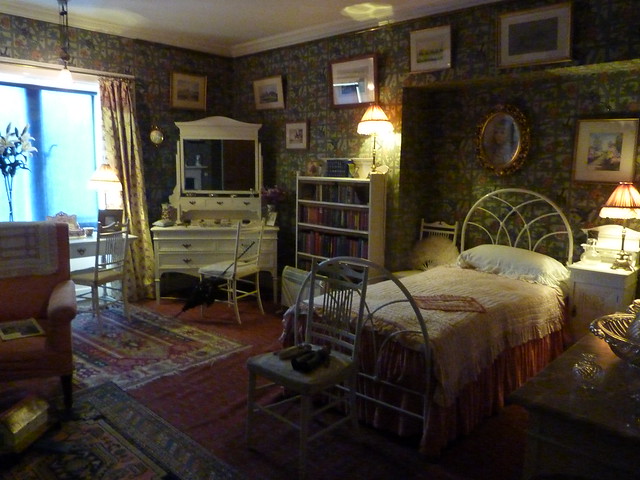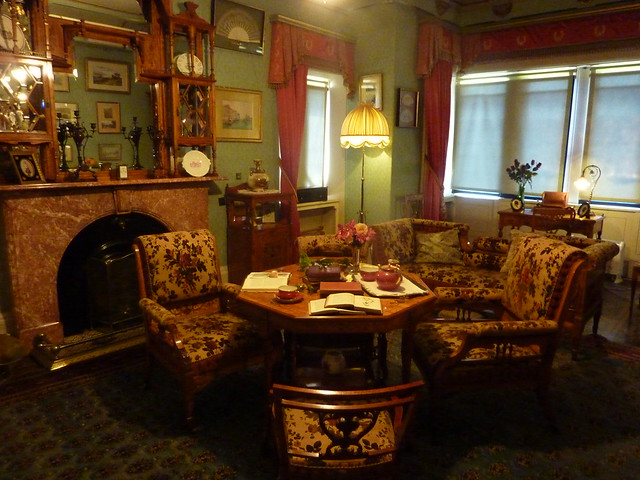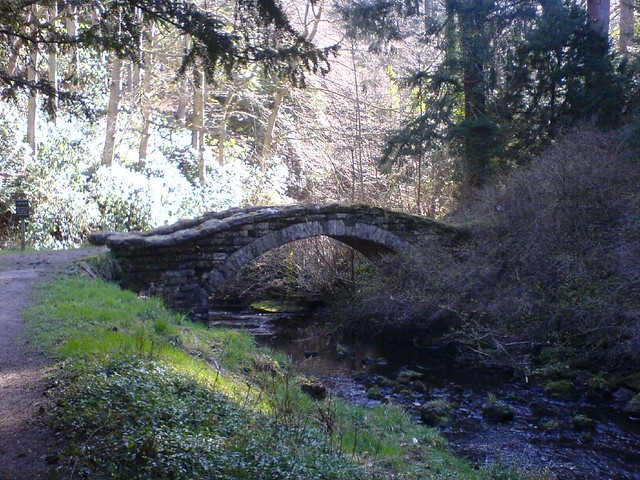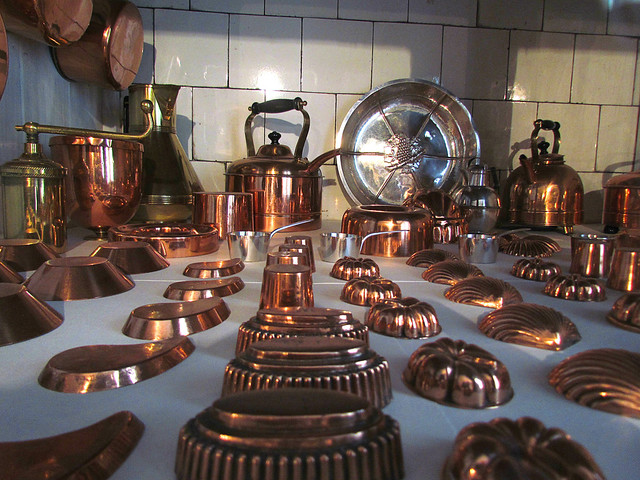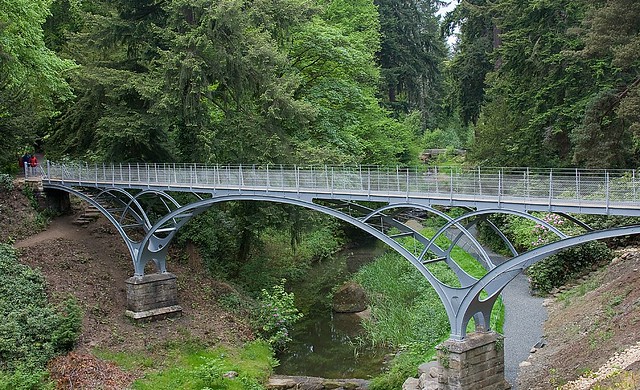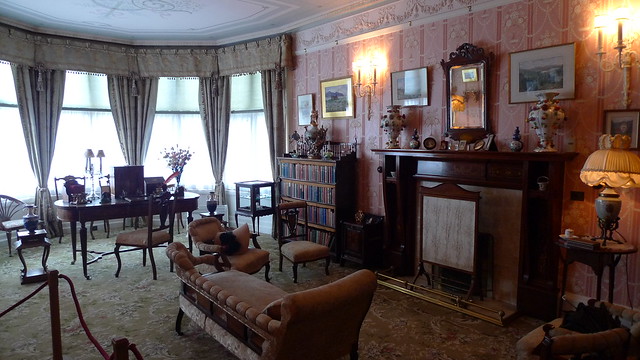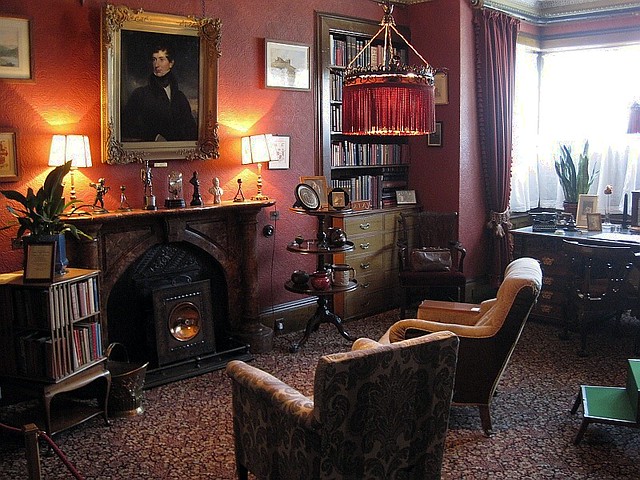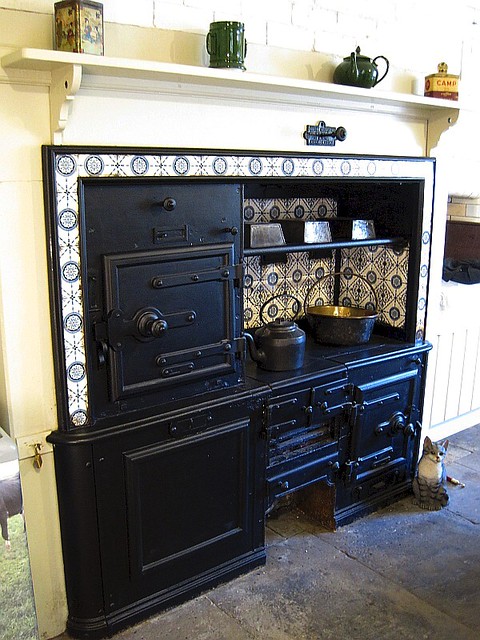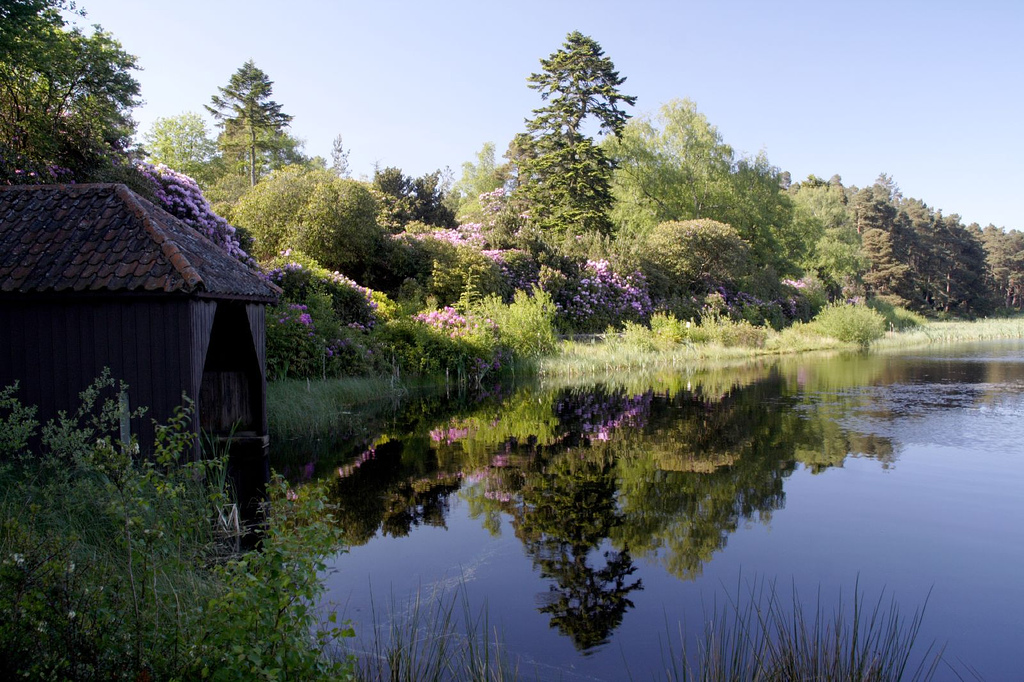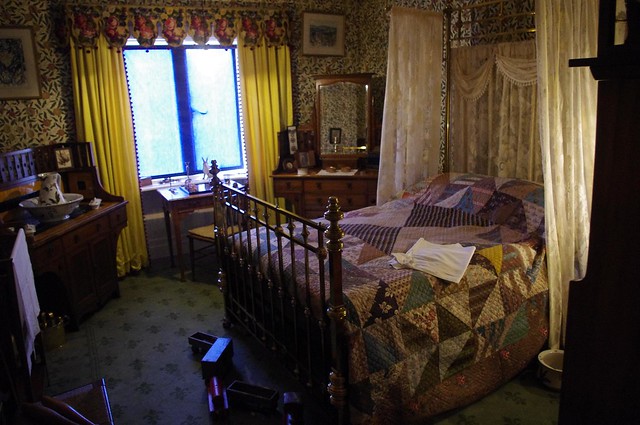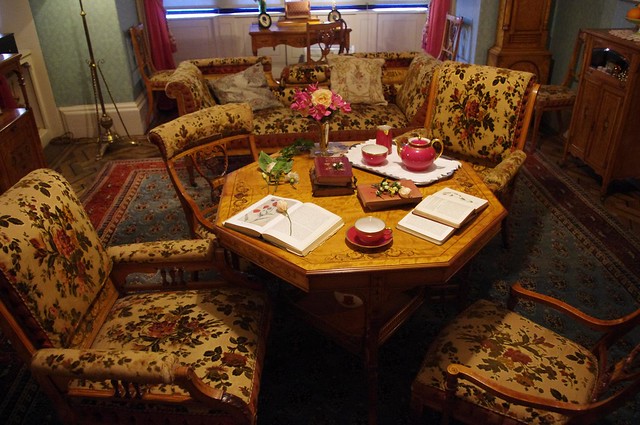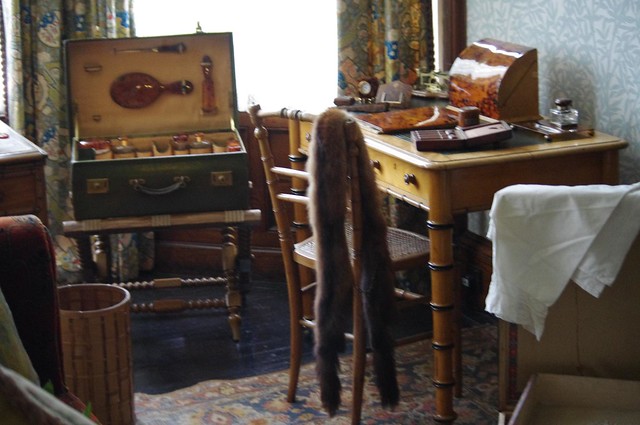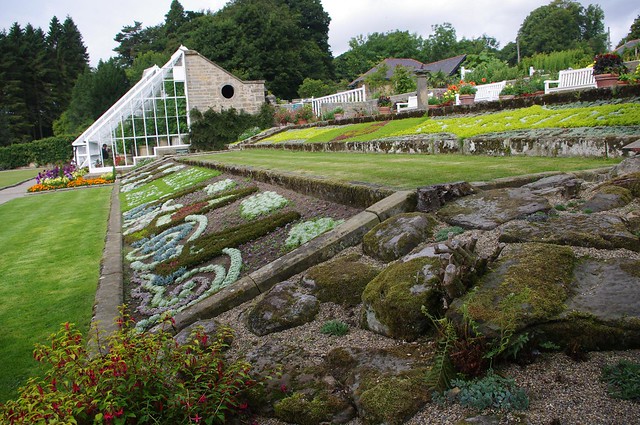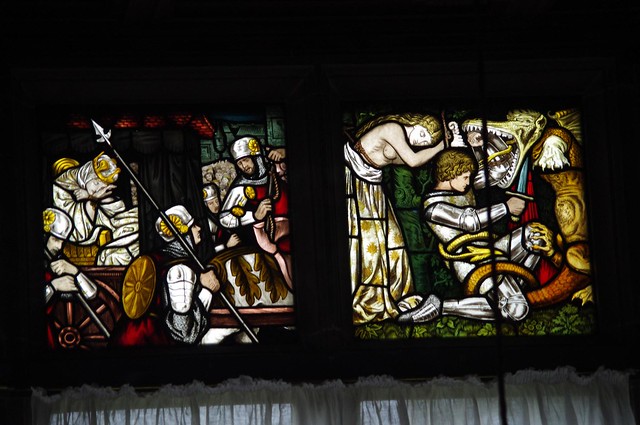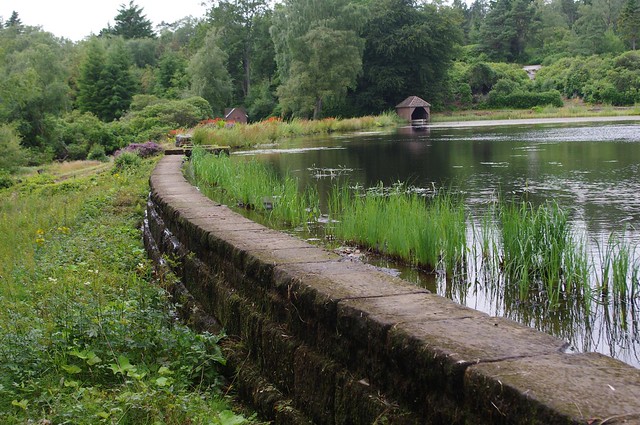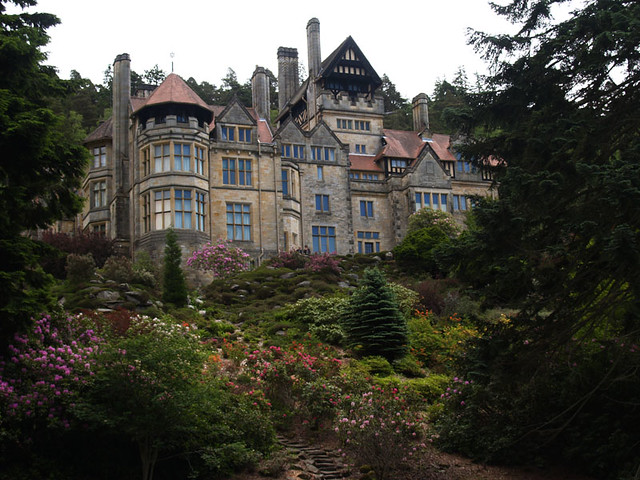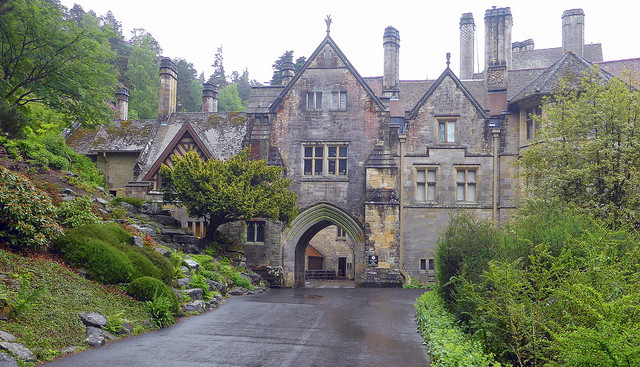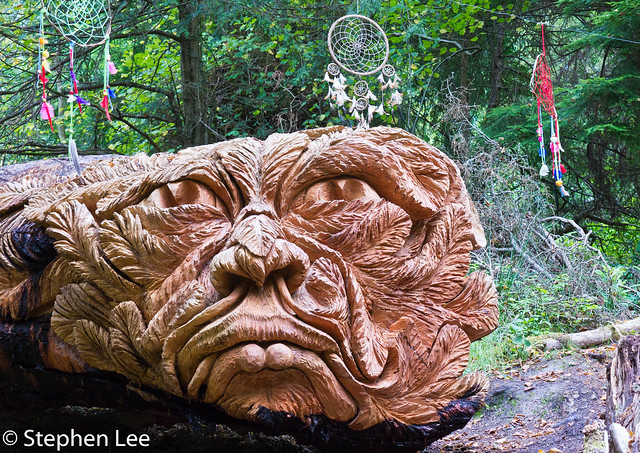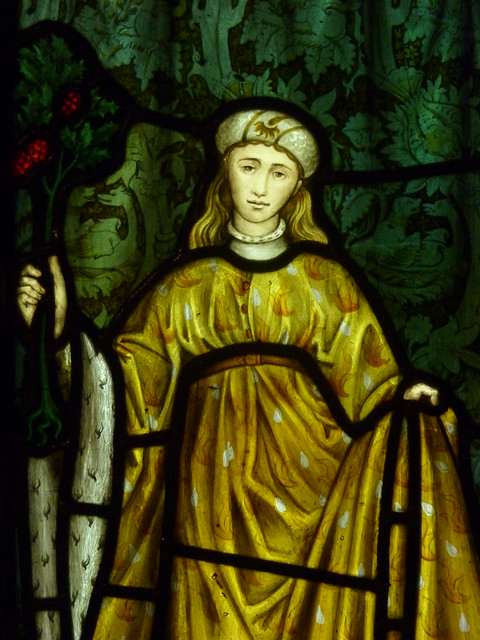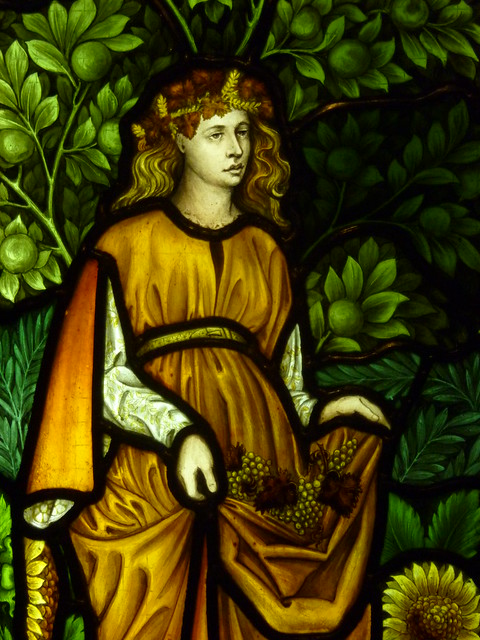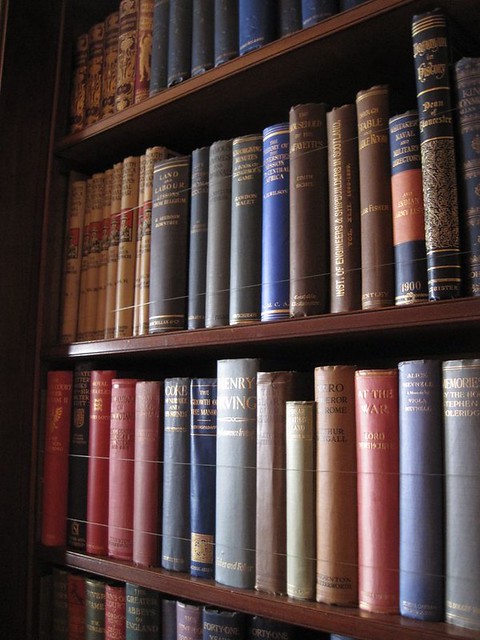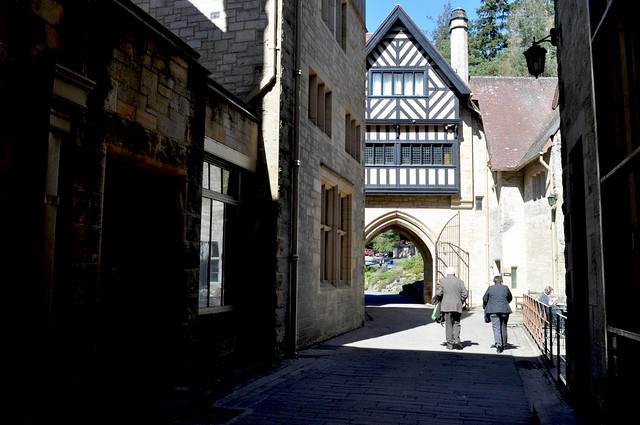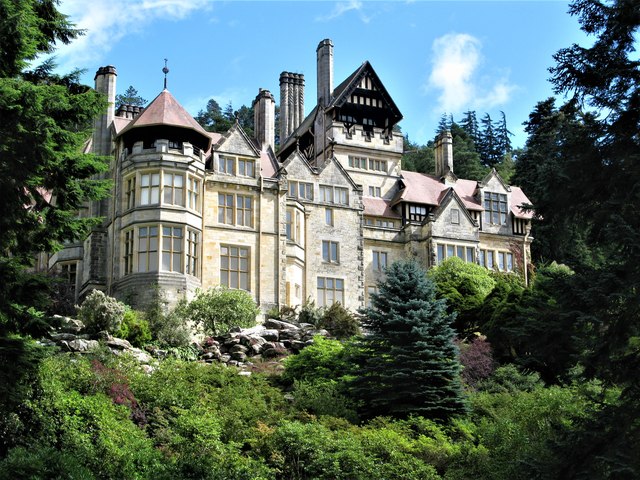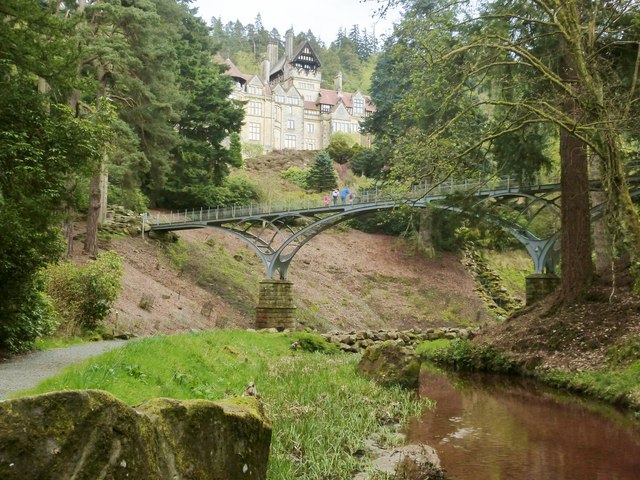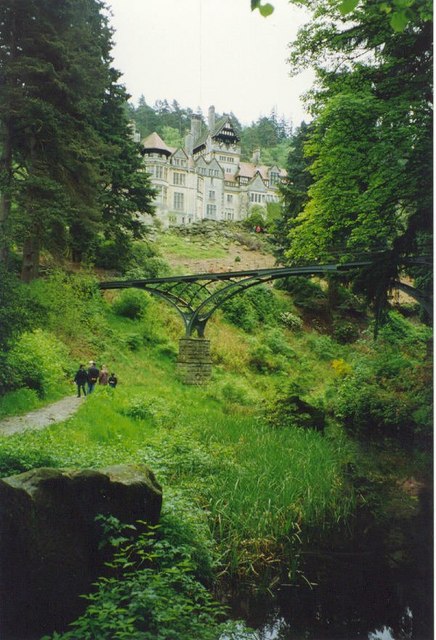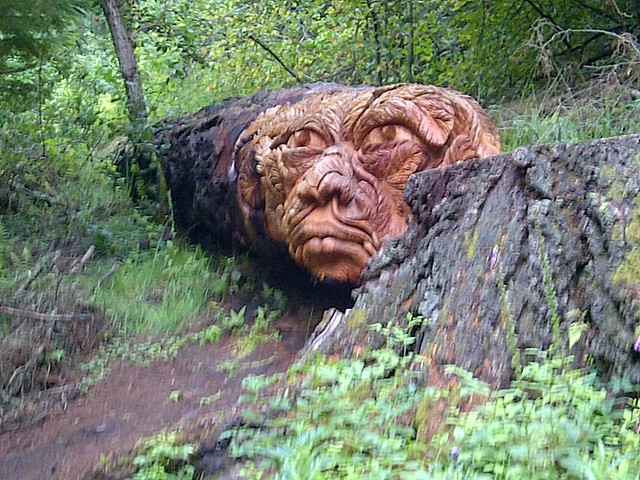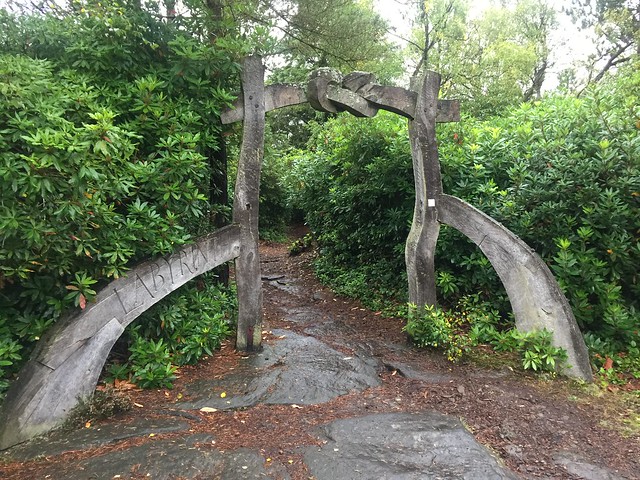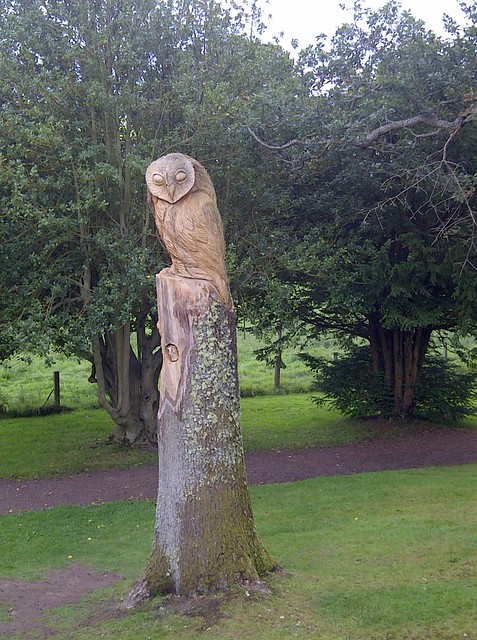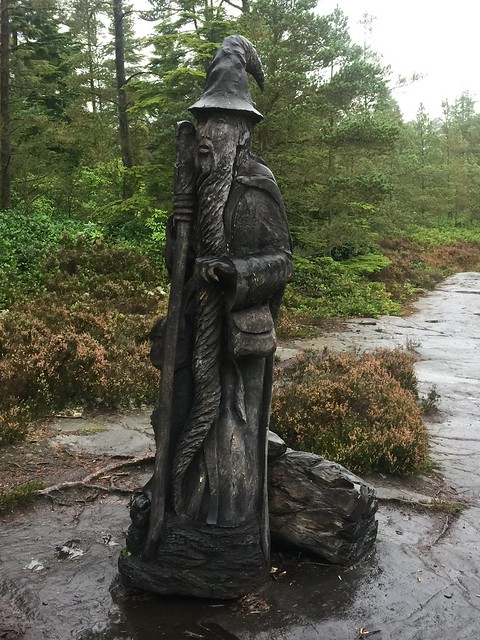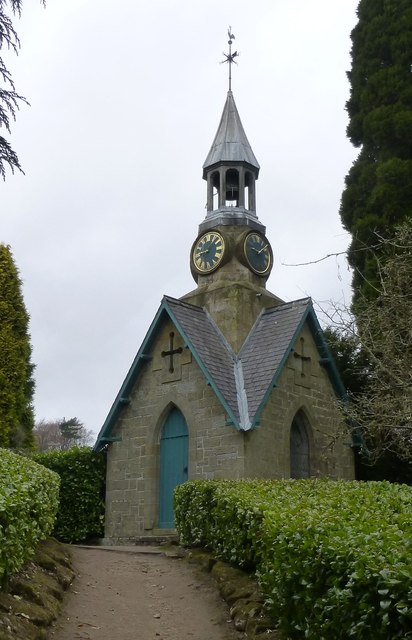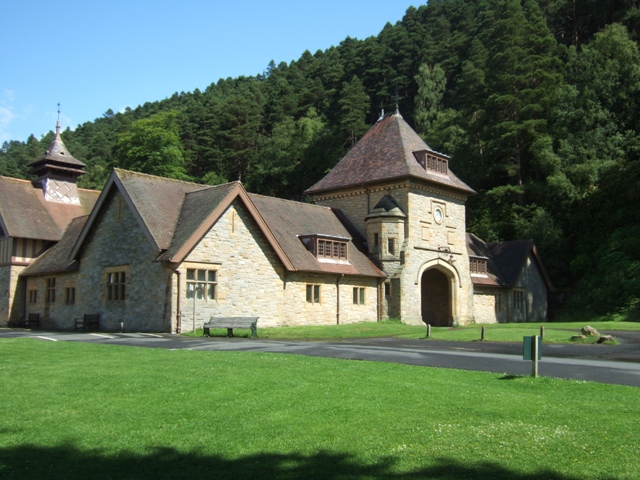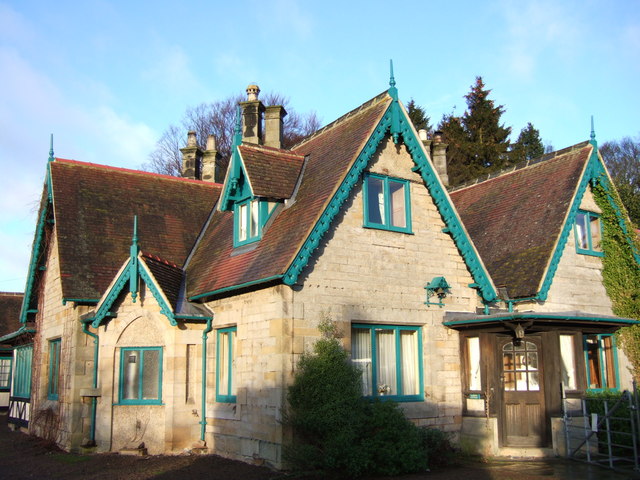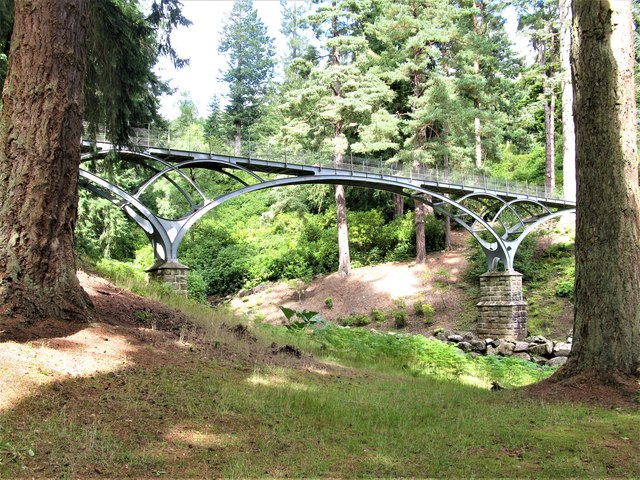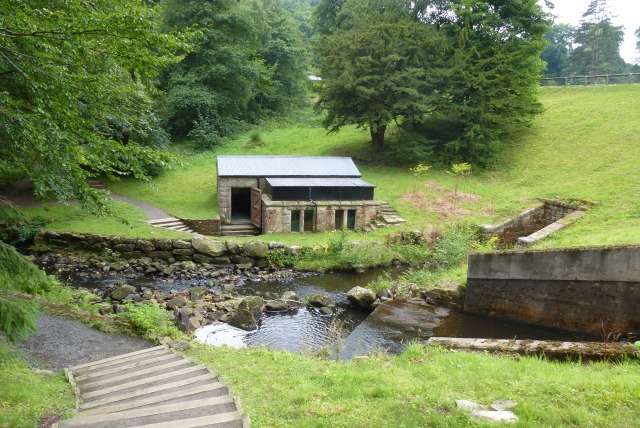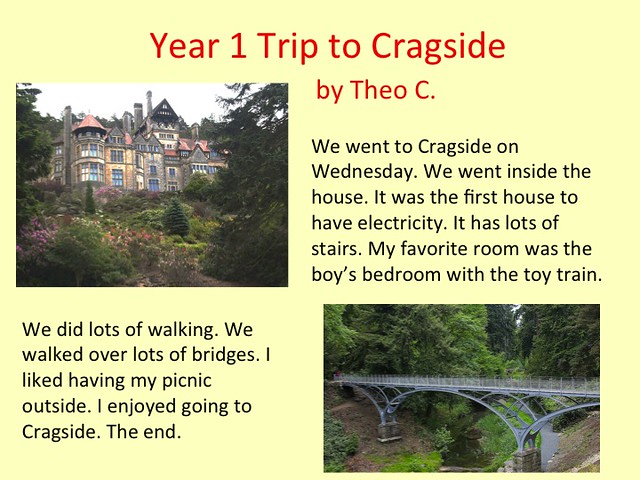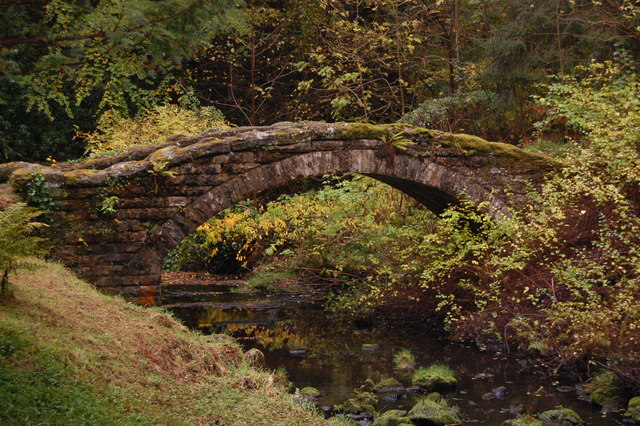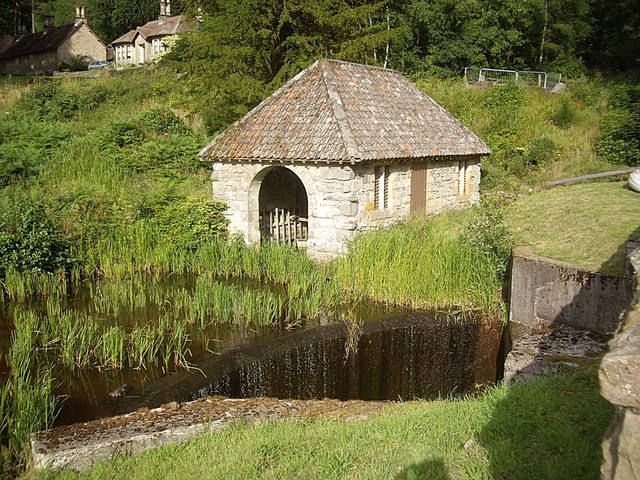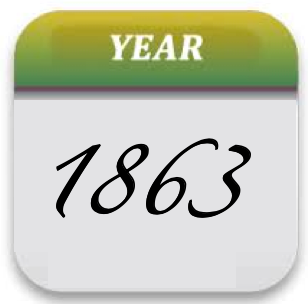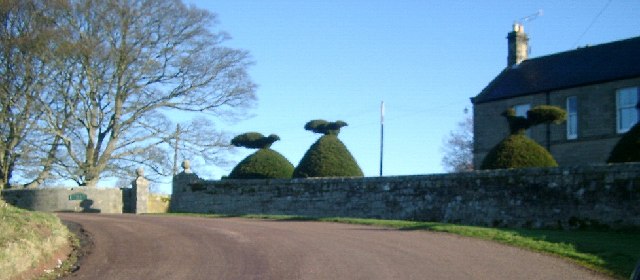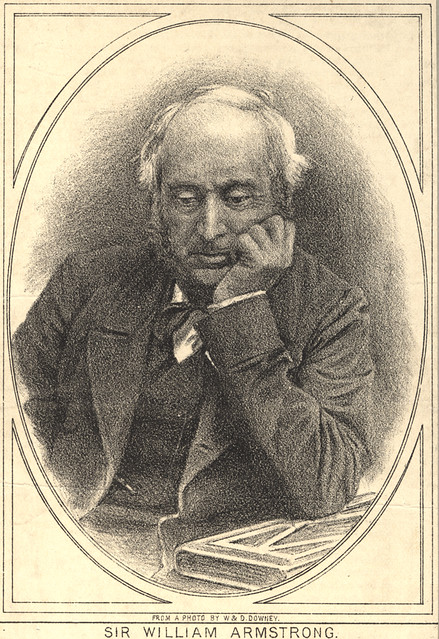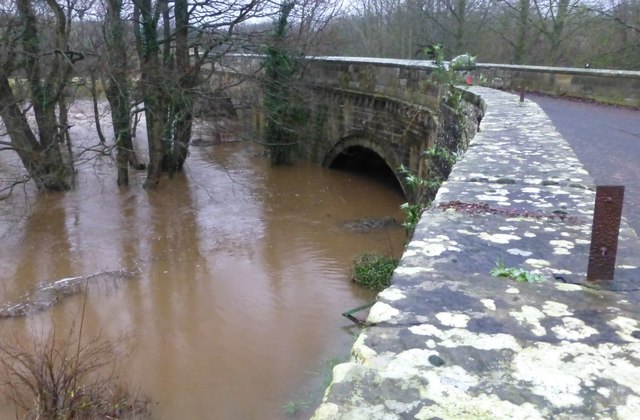Topics > Heritage Sites > Cragside
Cragside
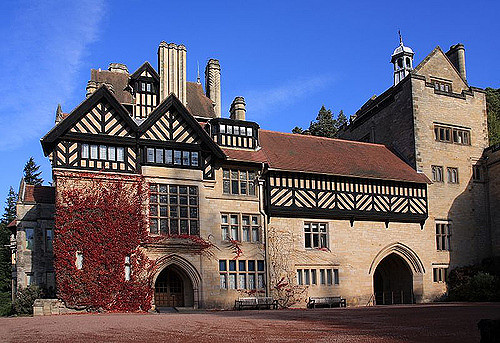 Cragside was the country house and estate of industrialist Lord William Armstrong and Lady Margaret Armstrong. It was the first house in the world to be lit using hydroelectric power. Located on a rocky hillside near Rothbury, Cragside was initially built in 1863 as a two-storey country lodge. It was later extended into a lavish mansion designed by Richard Norman Shaw in the “Free Tudor” style. The estate has extensive forest gardens, artificial lakes and rock gardens. Cragside is a Grade I listed building and the estate has been in the care of the National Trust since 1977.
Cragside was the country house and estate of industrialist Lord William Armstrong and Lady Margaret Armstrong. It was the first house in the world to be lit using hydroelectric power. Located on a rocky hillside near Rothbury, Cragside was initially built in 1863 as a two-storey country lodge. It was later extended into a lavish mansion designed by Richard Norman Shaw in the “Free Tudor” style. The estate has extensive forest gardens, artificial lakes and rock gardens. Cragside is a Grade I listed building and the estate has been in the care of the National Trust since 1977. Cragside is a Victorian country house near the town of Rothbury in Northumberland, England. It was the home of William Armstrong, 1st Baron Armstrong, founder of the Armstrong Whitworth armaments firm. An industrial magnate, scientist, philanthropist and inventor of the hydraulic crane and the Armstrong gun, Armstrong also displayed his inventiveness in the domestic sphere, making Cragside the first house in the world to be lit using hydroelectric power. The entire estate was technologically advanced, equipped with "wonderful hydraulic machines that do all sorts of things". In the grounds, Armstrong built dams and created lakes to power a sawmill, a water-powered laundry, early versions of a dishwasher and a dumb waiter, a hydraulic lift and a hydroelectric rotisserie. In 1887, Armstrong was raised to the peerage, the first engineer and the first scientist to be ennobled. He took his title from the name of his house, becoming Baron Armstrong of Cragside.
The original house on the site was a small shooting lodge which Armstrong built between 1862 and 1864. In 1868, he employed the architect R. Norman Shaw to extend a banqueting hall in his house in Newcastle. In 1869, Shaw was engaged to enlarge Cragside; in two phases of work between 1869 and 1882, he transformed the house into a northern Neuschwanstein. The result has been described as "one of the most dramatic compositions in all architecture". Armstrong filled the house with a significant art collection, he and his wife being patrons of many 19th-century British artists. Thus equipped and furnished, Cragside became an integral part of Armstrong's commercial operations; among others, the Shah of Persia, the King of Siam and the Crown Prince of Japan were fêted, and sold to, under Armstrong's roof.
Following Armstrong's death in 1900, his heirs struggled to maintain the house and estate. In 1910, the best of Armstrong's art collection was sold off, and by the 1970s, in an attempt to meet death duties, plans were submitted for large-scale residential development of the estate. In that period, when asked by the National Trust to compile a gazetteer of the most important Victorian houses in Britain which the Trust should seek to save should they ever be sold, the architectural historian Mark Girouard placed Cragside at the top of the list. In 1977, when the Armstrong family did sell up, the house passed to the Trust, with the aid of a grant from the National Land Fund. A Grade I listed building, Cragside has been open to the public since 1979.
History
Modern magician
William Armstrong was born on 26 November 1810 at Newcastle, the son of a corn merchant. Trained as a solicitor, he moved to London before he was twenty. Returning to Newcastle, in 1835 he met and married Margaret Ramshaw, the daughter of a builder. A keen amateur scientist, Armstrong began to conduct experiments in both hydraulics and electricity. In 1847, he abandoned the law for manufacturing and established W. G. Armstrong and Company at a site at Elswick, outside Newcastle. By the 1850s, with his design for the Armstrong Gun, Armstrong laid the foundations for an armaments firm that would, before the end of the century, see Krupp's as its only world rival. At the same time, he established himself as a figure of national standing, his work supplying artillery to the British Army being seen as an important response to the failures of Britain's forces during the Crimean War. In 1859, he was knighted and made Engineer of Rifled Ordnance in official recognition of his contribution to the nation's defence. The enormous fortune that flowed from these endeavours was to enable the building of Armstrong's fantasy palace on the Northumbrian moors.
Shooting box: 18621865
Armstrong had spent much of his childhood at Rothbury, escaping from industrial Newcastle for the benefit of his often poor health. He returned to the area in 1862, not having taken a holiday for over fifteen years. On a walk with friends, Armstrong was struck by the attractiveness of the site for a house and, returning to Newcastle, he arranged for the purchase of a small parcel of land and decided to build a modest house on the side of a moorland crag. He intended a "house of eight or ten rooms and a stable for a pair of horses". The house was completed in the mid-1860s by an unknown architect; a two-storey box of little architectural distinction, it was nevertheless constructed and furnished to a high standard.
Fairy palace: 18691900
The original connection between Armstrong and Shaw was made when Armstrong purchased a picture, Prince Hal taking the crown from his father's bedside by John Callcott Horsley, that proved too large to fit into his townhouse in Jesmond, Newcastle. Horsley, a friend of both, recommended Shaw to design a suitably-sized extension to the banqueting hall Armstrong had previously built in the grounds. When this was completed in 1869, Shaw was asked to propose enlargements and improvements to the shooting lodge Armstrong had constructed at Rothbury some four years earlier. This was the genesis of the transformation of the house between 1869 and 1884. The architectural historian Andrew Saint records that Shaw sketched out the whole design for the "future fairy palace" in a single afternoon, while Armstrong and his guests were out on a shooting party. Over the course of the next thirty years, Cragside became the centre of Armstrong's world; reminiscing years later, he remarked, "had there been no Cragside, I shouldn't be talking to you todayfor it has been my very life".
Shaw had begun his career in the office of William Burn and had subsequently studied under Anthony Salvin and George Edmund Street. The former had taught him the mastery of internal planning that was essential for the design of the large, and highly variegated, houses the Victorian wealthy craved. Salvin and Street had taught him to understand the Gothic Revival. At the young age of twenty-four he won the RIBA Gold Medal and Travelling Studentship. The knowledge Shaw gained was deployed to the full over the twenty years that he worked at Cragside. The long building period, and Armstrong's piecemeal, and changeable, approach to the development of the house, and his desire to retain the original shooting lodge at its core, occasionally led to tensions between client and architect and to a building that lacks an overall unity. Armstrong changed the purpose of a number of rooms as his interests developed and the German architectural historian, Herman Muthesius, writing just after Armstrong's death in 1900, noted that, "the house did not find the unqualified favour with Shaw's followers that his previous works had done, nor did it entirely satisfy (Shaw)". Nevertheless, Shaw's skills, as an architect and as a manager of difficult clients, ensured that Cragside, "in most views, (is composed) with memorable force".
Cragside also acted as an enormous display case for Armstrong's ever-expanding art collection. The best of his collection was hung in the drawing room, but Shaw also converted the museum into a top-lit picture gallery. Pride of place was given to John Everett Millais's Chill October, bought by Armstrong at Christie's in 1875, sold in the 1910 sale, and now in the private collection of Andrew Lloyd Webber. Armstrong also bought Millais's Jephthah's Daughter, now at the National Museum Cardiff, in the same sale, paying 900 guineas for the pair. Cragside was as much used as a setting for Armstrong's commercial activities as for a residence. The architectural writer Simon Jenkins records; "Japanese, Persian, Siamese and German dignitaries paid court to the man who equipped their armies and built their navies". Clive Aslet notes a visit with the same purpose from the Crown Prince of Afghanistan. The King of Siam was staying in 1897, when activity at the Elswick Works was disrupted by a bitter strike over pay and hours.
August 1884 saw a three-day visit to Cragside by the Prince and Princess of Wales, the apogee of Armstrong's social career. The royal arrival at the house was illuminated by ten thousand lamps and a vast array of Chinese lanterns hung in the trees on the estate, and by six balloons from which fireworks were launched, and a great bonfire lit on the Simonside Hills. On the second day of their visit, the Prince and Princess travelled to Newcastle, to formally open the grounds of Armstrong's old house, Jesmond Dean, which he had by then donated to the city as a public park. Three years later, at the time of the Golden Jubilee of Queen Victoria, Armstrong was ennobled as Baron Armstrong of Cragside. He was the first engineer and the first scientist to be granted a peerage. Among many other celebrations, he was awarded the freedom of the City of Newcastle. In his vote of thanks, the mayor noted that one in four of the entire population of the city was employed directly by Armstrong, or by companies over which he presided.
Armstrong's heirs: 1900the present
Armstrong died at Cragside on December 27th 1900, aged ninety, and was buried beside his wife in the churchyard at Rothbury. His gravestone carries an epitaph; His scientific attainments gained him a world wide celebrity and his great philanthropy the gratitude of the poor. Cragside, and his fortune, were inherited by his great-nephew, William Watson-Armstrong. Watson-Armstrong lacked Armstrong's commercial acumen and a series of poor financial investments led to the sale of much of the great art collection in 1910. In 1972, the death of Watson-Armstrong's heir, William John Montagu Watson-Armstrong, saw the house and estate threatened by large-scale residential development, intended to raise the sums of money necessary to meet a substantial inheritance tax bill. Some years earlier, when advising the National Trust on the most important Victorian houses to be preserved for the nation in the event of their sale, Mark Girouard had identified Cragside as the foremost priority. A major campaign saw the house and grounds pass to the Trust in 1977, with the aid of a grant from the National Land Fund.
In 2007, Cragside reopened after undergoing an 18-month refurbishment programme that included the rewiring of the entirety of the house. It has become one of the most-visited sites in North East England, with some 227,062 visitors in 2016. The Trust continues restoration work, allowing more of the house to be displayed; in 2016 Armstrong's electrical room was re-opened, in which he conducted experiments on electrical charges towards the end of his life. The experiments had led to the publication in 1897 of Armstrong's last work, Electrical Movement in Air and Water, illustrated with remarkable early photographs by his friend John Worsnop.
The Trust continues the reconstruction of the wider estate, with plans to redevelop Armstrong's glasshouses, including the palm house, the ferneries and the orchid house.
Architecture and description
Visitors Entrance Cragside - geograph.org.uk - 1529418.jpg|thumb|left|300px|The entrance front Shaw's Wagnerian overture
Cragside is an example of Shaw's Tudor revival style and his efforts created what Pevsner considers "the most dramatic Victorian mansion in the North of England". The entrance front was described by Harry Stuart Goodhart-Rendel as "one of the most dramatic compositions in all architecture", and James Stevens Curl thought the house "an extraordinarily accomplished Picturesque composition". Criticism focuses on the building's lack of overall coherence; Aslet and Powers describe the house as "large and meandering", and the architectural critics Dixon and Muthesius write that "the plan rambles along the hillside". Saint is even more dismissive; for him, "the plan of Cragside is little better than a straggle". The half-timbering used above the entrance has also been criticised, as unfaithful to the vernacular tradition of the North-East. Shaw would have been unconcerned; desiring it for "romantic effect, he reached out for it like an artist reaching out for a tube of colour".
The architectural historian J. Mordaunt Crook considers Cragside to be one of the very few country houses built by the Victorian commercial plutocracy that was truly "avant-garde or trend-setting". In his study, The Rise of the Nouveaux Riches, Crook contends that many new-monied owners were too domineering, and generally chose second-rate architects, rather than one of the first rank such as Shaw, as they tended to be more "pliant", allowing the clients to get their own way. The Rhenish flavour of the house makes a notable contrast with a country house that was almost contemporaneous with Cragside: the Villa Hügel constructed by Armstrong's greatest rival, Alfred Krupp. While Armstrong's Northumbrian fastness drew on Teutonic inspirations, his German competitor built a house that was an exercise in severe Neo-classicism.
The location for the house was described by Mark Girouard as "a lunatic site". Pevsner and Richmond call both the setting and the house Wagnerian. The ledge on which it stands is narrow, and space for the repeated expansions could only be found by dynamiting the rock face behind, or by building upwards. Such challenges only drove Armstrong on, and overcoming the technical barriers to construction gave him great pleasure, and was made easier by his use of the workforce and the technology of the Elswick Works. The architectural historian Jill Franklin notes that the vertiginous fall of the site is so steep that the drawing room, on a level with the first-floor landing at the front of the house, meets the rock face at the back.
Jenkins describes the plan of the house as "simpler than the exterior suggests". The majority of the reception rooms are located on the ground floor, as are the accompanying service rooms. The exception is the large extension Shaw added to the south-east from 1882. This includes the drawing room, completed in time for the visit of Edward VIII and Queen Alexandra, then Prince and Princess of Wales, in August 1884. The house is Grade I listed on the National Heritage List for England. Inside is a "largely complete Victorian interior". It is of national importance for its collections of furnishings, furniture (much designed especially for Cragside), and fine and decorative arts, with work by many notable designers of the age, including William Morris, Dante Gabriel Rossetti, Philip Webb and Edward Burne-Jones. Pevsner notes that the art collection demonstrated "what was permissible to the Victorian nobleman in the way of erotica".
Kitchen, service rooms and Turkish bath
The kitchen is large by Victorian standards and forms a considerable apartment with the butler's pantry. It displays Armstrong's "technical ingenuity" to the full, having a dumb waiter and a spit run on hydraulic power. An electric gong announced mealtimes. For the visit of Edward and Alexandra, Armstrong brought in the Royal caterers, Gunters, who prepared in the kitchen an eight-course menu which included oysters, turtle soup, stuffed turbot, venison, grouse, peaches in maraschino jelly and brown bread ice cream. Off the kitchen, under the library, is a Turkish bath suite, an "unusual item" in a Victorian private house. The writer Michael Hall suggests that the bath, with its plunge pool, was intended as much to demonstrate Armstrong's copious water supply as for actual use. As was often the case, Armstrong also found practical application for his pleasures: steam generated by the Turkish bath supported the provision of heating for the house.
Library and dining room
Girouard describes the library as "one of the most sympathetic Victorian rooms in England". It belongs to the first phase of Shaw's construction work and was completed in 1872. It has a large bay window which gives views out over the bridge and the glen. The room is half-panelled in oak and the fireplace includes fragments of Egyptian onyx, collected during Armstrong's visit to the country in 1872. The library originally contained some of Armstrong's best pictures, although most were rehung in the gallery and the drawing room, following Shaw's further building campaign of the 1880s, and then sold in the 1910 sale. The highlight was Albert Joseph Moore's Follow My Leader, dating from 1872. Andrew Saint considers the room "Shaw's greatest domestic interior". The dining room off the library contains a "Gothic" fireplace, with another of Shaw's inglenooks. A famous portrait of Armstrong by Henry Hetherington Emmerson shows him relaxing as a "modest Victorian plutocra(t)", sitting in the inglenook with his dogs, under a carved inscription on the mantlepiece reading East or West, Hame's Best. The stained glass in the windows of the inglenook is by William Morris, and other glass from Morris & Co., to designs by Rossetti, Burne-Jones, Webb and Ford Maddox Brown, was installed in the library, the gallery and in the stairwells.
Owl suite
The Owl rooms were constructed in the first building campaign and form a suite for important guests. Their name derives from the carved owls that decorate the woodwork and the bed. The room is panelled in American Black walnut, the same wood from which the tester bed is carved. Saint notes that Shaw was "proud of the design", displaying a further "owl-bed" in an exhibition in 1877. The Prince and Princess of Wales occupied the rooms during their stay at Cragside in 1884. Other bedrooms, notably the Yellow and White rooms, were hung with wallpaper by William Morris, including early versions of his Fruit and Bird and Trellis designs. The wallpapers were reprinted using the original printing blocks and rehung in the Trust's renovations.
Gallery
The gallery originally formed Armstrong's museum room and was built by Shaw between 1872 and 1874. It led to the observatory in the Gilnockie Tower. Later, the room formed a processional route to the newly-created drawing room, and was transformed into a gallery for pictures and sculpture. Its lighting displayed further evidence of Armstrong's technical ingenuity. Provided with twelve overhead lamps, the lighting for the room could be supplemented by a further eight lamps, powered by electric current "shunted from the lamps in the dining room (when they were) no longer wanted". Lighting, and his means of providing it, mattered to Armstrong, on both technical and aesthetic levels; "in the passageways and stairs the lamps are used without shades and present a most beautiful and star-like appearance."
Drawing room
The drawing room was constructed in the 1880s phase of building, when Armstrong had sold his Jesmond house and was residing solely at Cragside. Aslet suggests that the inspiration for the design was the great hall at Haddon Hall, Derbyshire, although Saint consider Shaw's Dawpool Hall, Cheshire as the more likely source. Pevsner and Richmond also suggest Hardwick Hall and Hatfield House as models for the "spectacular" overall design. The room contains a colossal marble inglenook chimneypiece, reputed to weigh ten tons, and designed by Shaw's assistant, W. R. Lethaby. Muthesius describes the fireplace as a "splendid example(.), with finely composed relief decoration". Jenkins considers it "surely the world's biggest inglenook" and describes the overall impact of the room as "sensational", noting the top-lit ceiling and the elaborate Jacobethan plasterwork. Others have been less complimentary; the writer Reginald Turnor, no admirer either of Shaw or of Victorian architecture and its architects more generally, wrote of the room's "flamboyant and rather sickening detail". By the time of its construction, Shaw, increasingly working for clients of great wealth, had moved on from his "Old English" style, and the room is designed and decorated in a grander and more opulent Renaissance taste.
Billiard room
The billiard room extension of 1895 is by Frederick Waller. It replaced a laboratory, in which Armstrong conducted experiments in electric currents. The billiard table and furniture was supplied by Burroughes and Watts. The billiard room and adjacent gun room formed a smoking suite, the previous absence of which was evidenced in a watercolour painted to commemorate the visit of the Prince and Princess of Wales. The Prince and Armstrong are shown smoking cigars on the terrace, as Victorian convention did not permit smoking in the principal reception rooms.
Technology
After his first visit to Cragside in 1869, Shaw described the house in a letter to his wife, noting the "wonderful hydraulic machines that do all sorts of things you can imagine". By building dams, Armstrong created five new lakes on the estate, Debden, Tumbleton, Blackburn, and the Upper and Lower lakes at Nelly's Moss. In 1868, a hydraulic engine was installed, with water being used to power labour-saving machines such as laundry equipment and a hydraulic lift. Inspired by a watermill on the Dee in Dentdale, in 1870 Armstrong installed a Siemens dynamo in what was the world's first hydroelectric power station. The resultant electricity was used to power an arc lamp installed in the picture gallery in 1878. The arc lamp was replaced in 1880 by Joseph Swan's incandescent lamps in what Swan considered "the first proper installation" of electric lighting. Armstrong knew Swan well and had chaired the presentation of Swan's new lamps to the Literary and Philosophical Society of Newcastle upon Tyne. Cragside was thus the "first (house) in the world to be lit by electricity derived from water power".
The use of electricity to run the house's appliances and internal systems made Cragside an early smart home; one of the first private residences to use incandescent lighting, a dishwasher, a vacuum cleaner and a washing machine, Cragside was "the place where modern living began". The spits in the kitchen were also powered by hydraulics. The conservatory contained a self-watering system for the pot plants, which turned on water-powered revolving stands. Telephony was also introduced, both between the rooms in the house, and between the house and other buildings on the estate. A plaque at Bamburgh Castle, Armstrong's other residence on the Northumbrian coast, records that his development of these new automated technologies "emancipated (.) much of the world from household drudgery". The generators, which also provided power for the farm buildings on the estate, were constantly extended and improved to meet the increasing electrical demands in the house. The 2006 regeneration project included extensive rewiring. A new screw turbine was installed in 2014; it can provide 12 kW, supplying around 10 per cent of the property's electricity consumption. The new system uses a -long Archimedes' screw.
Grounds and estate
Cragside, named after Cragend Hill above the house, is surrounded by an extensive rock garden, with a collection of rhododendrons, one of which is named after Lady Armstrong, who made a considerable contribution to the design and construction of the gardens, and large plantings of mostly coniferous trees. Among these is the tallest Scots pine in Britain, at a height of 131ft (40m). Over one hundred years after their planting, Jill Franklin wrote that, "the great, dark trees form a protective barrier to (Armstrong's) home". Armstrong bought land continuously after the purchase of the original site and by the 1880s the gardens and grounds comprised some 1,700 acres, with the wider estate, including Armstrong's agricultural holdings, extending to 15,000 acres, according to Armstrong's most recent biographer, Henrietta Heald, and to over 16,000 acres according to the historian David Cannadine. David Dougan records the traditional claim that Armstrong planted over seven million trees in the gardens and parkland. The estate provides sanctuary for "some of the last red squirrels remaining in Britain". The glen north-west of the house is spanned by an iron bridge, crossing the Debden Burn, constructed to Armstrong's design at his Elswick Works in the 1870s. It is a Grade II* listed structure and was restored by the Trust, and reopened to the public, in 2008-2009. The gardens themselves are listed Grade I, and a number of the architectural and technological structures have their own historic listings. The Clock Tower, which regulated life on the estate, dates from the time of the construction of the shooting lodge, and may have been designed by the same architect. It is not by Shaw. It is possible that Armstrong himself may have designed the clock. Like the bridge, the Clock Tower has a Grade II* listing. The formal gardens, where Armstrong's great greenhouses stood and which were long separated from the main estate, have now been acquired by the Trust.
Media appearances
Cragside has featured in an Open University Arts Foundation Course, Jonathan Meades's documentary series Abroad Again in Britain, BBC One's Britain's Hidden Heritage, and Glorious Gardens from above, and ITV's series Inside the National Trust. The 2017 film, The Current War, was partly filmed at the estate.

from http://www.nationaltrust.org.…
Cragside - National Trust
- Official Website of Cragside including visitor information and pages summarising its history.
Added by
Simon Cotterill

from Flickr (flickr)
Monster carved in wood - Cragside, Rothbury, Northumberland
Pinned by Simon Cotterill

from Newcastle libraries (flickr)
021990:Sir William Armstrong Worsnop John Undated
Pinned by Simon Cotterill
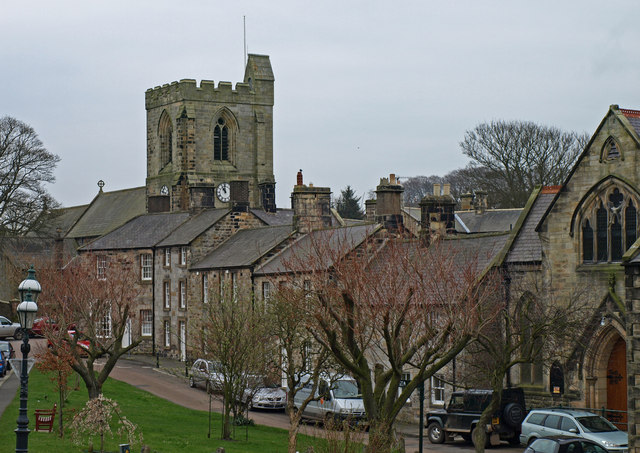
Co-Curate Page
Rothbury
- Overview Further Information Map Street View Rothbury is a traditional market town which straddles the River Coquet. It is located in central Northumberland just over 13 miles noth west of …


from http://www.nationaltrust.org.…
Cragside - National Trust
- Official Website of Cragside including visitor information and pages summarising its history.
Added by
Simon Cotterill

from Flickr (flickr)
Monster carved in wood - Cragside, Rothbury, Northumberland
Pinned by Simon Cotterill

from Newcastle libraries (flickr)
021990:Sir William Armstrong Worsnop John Undated
Pinned by Simon Cotterill

Co-Curate Page
Rothbury
- Overview Further Information Map Street View Rothbury is a traditional market town which straddles the River Coquet. It is located in central Northumberland just over 13 miles noth west of …
List number: 1042076
Post code: NE65 7PX
County: Northumberland
Grid ref: NU0737502173

